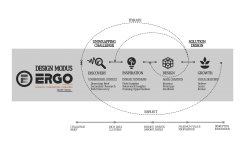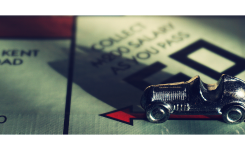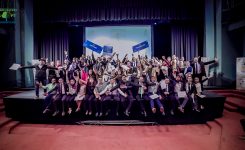Innovation Design
BUILDING A CULTURE OF INNOVATION
The financial crunch in the past decade has caused many disruptions in consumer markets. Globally, products are transforming into commodities, experiences are prioritized over products, and people are turning to shared economy to exploit less utilized assets, and create new sources of revenue. Through building a culture of innovation, companies like UBER and AIRBNB were able to take great advantage of those disruptions to rise in a formidable economic climate.
Companies now understand the potential of investing in innovation, but many executives fear its price tag. Research by McKinsey & Co. revealed 94 percent of surveyed executives were unhappy with their company’s innovative performance. However, investing in innovation strategies can be daunting if the company does not have the right culture. “Culture eats strategy for breakfast.” – a phrase originated by Peter Drucker, forms an absolute reality in today’s business world! Any company disconnecting the two are risking their progress and success. In fact, the cost of innovation does not have to be high, if you build the right culture. Although there is no silver bullet to building a culture of innovation, here are some advice that work across industries.
BELIEVE IN EVERYONE’S CREATIVE ABILITIES
We are all born creative; with a natural ability to come up with original ideas, and the courage to try them out. However, society and formal education let doubt get between us and our creative capacity. To put it differently, people seem to have lost their creative confidence. Thus, in the search for innovation, leaders must help their teams rebuild their confidence, and give everyone a safe space to take creative risks, without fear of rejection or ridicule. Restoring their creative confidence is one of the biggest investments a leader could make in a disruptive economy.
EMBRACE AMBIGUITY
Fear of ambiguity is one of the strongest barriers to innovation. With this in mind, we must learn to embrace ambiguity, and give ourselves the permission to explore untraveled territories. We must approach the unknown with a design mentality of human-centered discovery. Seek breadth to understand context, seek depth to thoroughly understand users, and seek nontraditional sources to unearth hidden insights that will serve as the basis for innovation.
BUILD DIVERSE, TRANSDISCIPLINARY TEAMS
Many people believe that creativity is a spur of the moment enlightenment, a sudden inspiration, or a lucky coincidence. However, the fact of the matter is that creativity is an inspiration process, which blooms by cross-pollination between multiple domains. How would a sociologist, a teacher, an engineer, a biologist, a behavioral scientist, an economist or an artist tackle a business innovation challenge in your industry? For instance, the engineer might focus on the technology, the behavioral scientist might focus on the user experience, the sociologist might focus on the community dynamics, the economist might focus on the financial viability. Now, imagine the outcome when we bring them together on the same team, under the right culture! It is not about thinking outside the box, it’s about expanding our box. Creativity favors the connected mind!
START EVERY ENGAGEMENT WITH A FRESH EYE
Many business decisions are taken on gut feelings. In fact, over-reliance on intuition puts too much faith in unconscious processing of information in our brain, without the ability to express reason. Every context is different; every user group is different. Learnings uncovered in field research are oftentimes unique to the user group and their environment, and do not necessarily follow our intuitive judgement and predictions. With this in mind, we must adopt a process of conscious discovery; start every engagement with a fresh eye, uncluttered by norms, personal judgement and past experiences. Insights are often unanticipated; do not let your past experience blur your future judgement.
EXPERIMENTATION IS YOUR CATALYST FOR SUCCESS
People tend to be their own worst critics; they self-censor, killing potentially innovative ideas because of their fear of failure. Thus, we must help teams get over their fears, and develop a more courageous attitude towards experimentation. Cross the thinking-doing gap early on in the problem solving process by slicing challenges into smaller parts, and designing quick prototypes for insightful feedback that guides the iterative design process. Some iterations are destined to fail, embrace this fact! It is better to fail early when the stakes are low. Learn from those failures to make your idea stronger with every iteration.
HIRE FOR ATTITUDE, TRAIN FOR SKILL
Building the right team helps you build the right culture. A rule of thumb, it is easier to train for skills than train for attitude. Scout people who have a growth mindset – with a desire to learn and a belief that abilities can be acquired. A sense of self efficacy – having confidence in their own ability to triumph above all obstacles. An abundance mentality – they think big, and are always happy to share knowledge and collaborate. Flexible – are able to look at problems from different perspectives. Non-conforming – are curious and do not follow conventions. Risk taking, and are not afraid of being wrong.
Creating a culture ripe for innovation is critical to an organization’s competitive positioning and growth. Most companies understand the value of innovation, but fall short when it comes to execution. Cultures do not create themselves, and undoubtedly are not achieved by simply adopting creativity tools and artifacts. Innovation starts with a mindset; going outside of your comfort zone, embracing ambiguity, making the familiar strange, fostering connectedness, and having faith in your team’s abilities.
Get in touch and let us start the conversation on how ERGO can help you build a culture of innovation.











